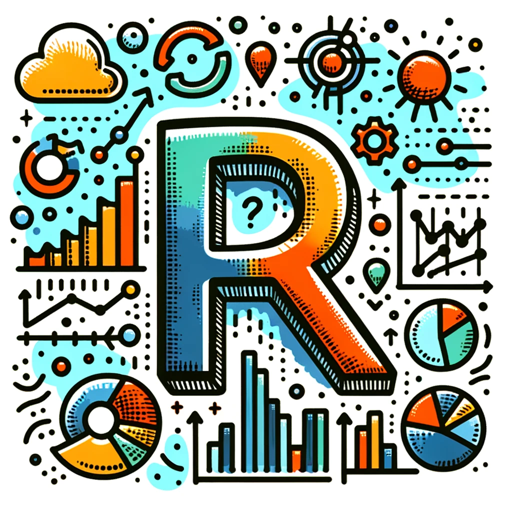Data Analysis: R Programming Essentials-R data frame manipulation guidance
AI-powered R programming assistant for data analysis
Help me create a data frame.
How do I import data in R?
Explain data types in R data frames.
Show me how to sort data in R.
Related Tools
Load More
Statistic & Data Analyst
Statistic and Data Analyst assistent

R coding - Advanced AI Assistant
Generates, explains, & optimizes R code

Advanced R Code and Statistical Consultant
The Most Advanced GPT for Statistics and R Code

Analysis with R
An expert in data analysis using the R programming language.

R-GPT
R Programming & Data Analysis Specialist

R Guru
Expert in R for data science, statistical analysis, machine learning and deep learning
20.0 / 5 (200 votes)
Introduction to Data Analysis: R Programming Essentials
Data Analysis: R Programming Essentials is designed to facilitate the mastery of R programming, specifically focusing on data frames as a core tool for data manipulation, cleaning, and analysis. Its goal is to help users learn how to efficiently handle large datasets, making use of R's powerful functions for data wrangling, analysis, and visualization. It emphasizes real-world applications such as handling missing data, performing statistical analysis, and visualizing trends with R's plotting libraries. This framework is not just about teaching syntax but helping users understand the logical flow of data transformation in R, ensuring they can apply these skills to complex, practical problems. For example, imagine you're working with sales data that includes missing entries. Data Analysis: R Programming Essentials would guide you through how to clean the data using functions like `na.omit()` or `mutate()` from `dplyr` to handle missing values, enabling more accurate analysis. Similarly, if you needed to merge customer data from multiple sources, it would provide tools to efficiently combine datasets using `merge()` or `dplyr::join()` functions.

Main Functions of Data Analysis: R Programming Essentials
Data Frame Manipulation
Example
Using `dplyr` for filtering, selecting, and summarizing data.
Scenario
A researcher needs to filter a dataset of 100,000 rows to find observations that meet specific conditions. Using `filter()` in conjunction with `mutate()` allows them to create a new column based on conditions while keeping the code concise and readable.
Handling Missing Data
Example
Using `na.omit()` or `replace_na()` to manage missing values.
Scenario
An analyst receives a dataset with missing income data. Before performing analysis, they use `na.omit()` to remove rows with missing values, or alternatively, apply `replace_na()` to fill in missing values with the median income, ensuring the dataset is complete and ready for statistical modeling.
Data Aggregation and Summarization
Example
Applying `group_by()` and `summarize()` to compute summary statistics for grouped data.
Scenario
A marketing team needs insights into customer spending by region. They use `group_by(region)` and `summarize(mean_spending = mean(spending))` to calculate the average spending per region, enabling them to target regions with higher purchasing power.
Ideal Users of Data Analysis: R Programming Essentials
Data Analysts and Statisticians
These users regularly work with datasets, performing exploratory data analysis (EDA), hypothesis testing, or building statistical models. R Programming Essentials provides them with tools to clean, process, and analyze large datasets efficiently. With a strong emphasis on functions like `lm()` for linear modeling or `ggplot2` for visualizations, they can quickly turn raw data into meaningful insights.
Researchers and Academics
Researchers often handle diverse types of data that require pre-processing and analysis. This service benefits them by offering comprehensive tutorials and tools for complex data transformations, statistical inference, and reproducible research. They can, for instance, analyze experimental data, use R Markdown for reproducible reports, and employ `tidyr` to restructure data into tidy formats.

How to Use Data Analysis: R Programming Essentials
Step 1
Visit aichatonline.org for a free trial without login, also no need for ChatGPT Plus.
Step 2
Familiarize yourself with the core features such as R code generation, data frame manipulation, and data analysis tools specifically tailored for handling large datasets in R.
Step 3
Ensure you have basic prerequisites like an understanding of R programming fundamentals, particularly with data structures like data frames and vectors, as well as a working R environment installed on your machine.
Step 4
Utilize the tool to receive detailed, context-specific R code snippets for tasks like data transformation, aggregation, missing value handling, and applying functions to data frames.
Step 5
Experiment with real-world datasets and projects, leveraging the tool’s detailed explanations, debugging tips, and tailored R code to boost your data analysis capabilities.
Try other advanced and practical GPTs
Find Jobs - Real time Open Jobs (US, EU...)
AI-Powered Real-Time Job Search

🦾 22.500+ Best Custom GPTs v2.0 (5.0⭐)
AI-powered custom GPTs for everyone

Automated Career Profile Analyst and Resume Tailor
AI-Powered Career and Resume Tailoring

Video Summary
AI-powered YouTube video summarization.

Ask the Shaman
AI-powered spiritual guidance and healing.

MR Questionnaire Guide
AI-driven Questionnaire Drafting Tool
Python Plotting Power Plays
AI-powered Python plotting and analysis.

100 Experts Collective
Your AI-powered expert network

Crypto Trends - Real time Coin price
AI-powered real-time crypto price insights

Say It Right Writer
AI-powered writing made clear and concise.

Lingua Maven
AI-Powered Linguistic Insights

Anki QuickCard
AI-powered flashcards for effective learning

- Code Debugging
- Visualization
- Data Cleaning
- Transformation
- Data Aggregation
Common Q&A About Data Analysis: R Programming Essentials
What specific R programming tasks does this tool assist with?
The tool provides expert guidance in tasks such as data frame manipulation, data cleaning, aggregation, visualization, and applying custom functions to large datasets. It also offers debugging tips and detailed explanations for complex operations in R.
How can I use this tool to enhance my data analysis skills?
The tool offers in-depth code generation and explanations for various data analysis processes. By working with real data, practicing with the provided code, and exploring different data transformation techniques, you can improve your R programming and data analysis proficiency.
Do I need prior R programming experience to use this tool?
Yes, having a basic understanding of R programming, particularly data frames and basic syntax, is recommended. This tool builds upon fundamental knowledge to provide advanced support in data manipulation and analysis.
Can this tool help with debugging R code?
Yes, the tool offers debugging support by generating detailed R code and highlighting potential pitfalls in your data manipulation processes. It also provides troubleshooting tips for common errors.
Does the tool support the integration of R code with real-world datasets?
Absolutely. You can use the generated R code to manipulate, analyze, and visualize real-world datasets. The tool’s focus on practical, hands-on code ensures seamless integration with external data sources and projects.